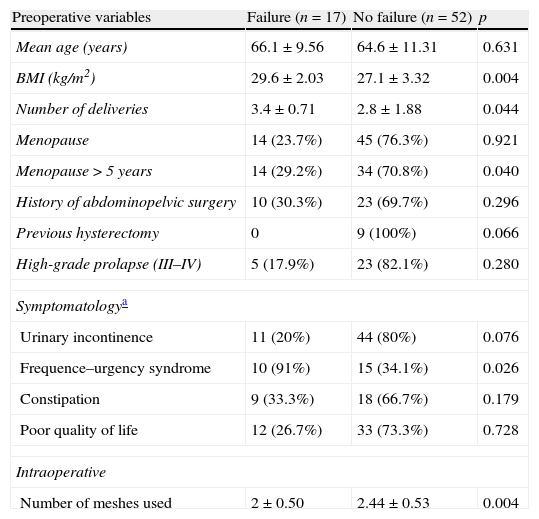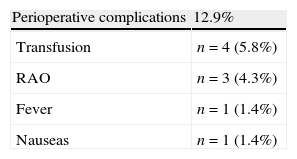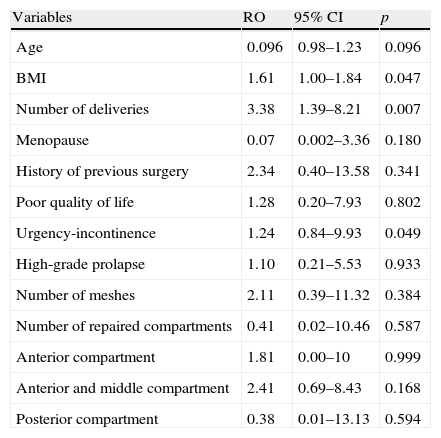Pelvic organ prolapse (POP) surgery has variable results of recurrence and complications. We have aimed to analyze our outcomes in order to know the factors associated with anatomical and functional failures after POP surgery.
Materials and methodsA retrospective study of 69 patients who underwent POP surgery at our hospital was performed. Registered variables were age, BMI, number of deliveries, previous pelvic surgery, menopause, quality of life, urinary incontinence, associated frequency–urgency symptoms, high POP stage, vaginal compartments repaired, type of mesh, urethro-suspension and vaginal hysterectomy during POP surgery and its complications. Patients were evaluated at 1, 6 and 12 months post-surgery. The technique was considered as failed when relapse or mesh erosion occurred and when the patient is not satisfied or there was relapse. The sample is described, analyzing the relationship of the variables studied by univariate analysis (Chi square and Mann–Whitney U tests) and a study was made; of which variables may have predictive value in the failure of the repair (multiple logistic regression).
ResultsSurgery failed in 17 patients during the follow-up at one year. BMI (29.6±2.03 vs. 27.1±3.32), delivery number (3.4±0.71 vs. 2.8±1.88), menopause, frequency–urgency symptoms and number of vaginal compartments repaired were associated with treatment failure although only BMI, delivery number and frequency–urgency symptoms were defined as independent predictive variables when the logistic regression was carried out.
ConclusionsOverweight/obesity, previous delivery number and frequency–urgency symptoms before surgery are factors associated to anatomical and functional failure after POP repair.
La cirugía del prolapso de órganos pelvianos (POP) presenta resultados variables de recurrencia y complicaciones. El objetivo es analizar nuestros resultados para conocer los factores que se asocian al fracaso anatómico y funcional tras la corrección con malla del POP.
Materiales y métodosEstudio retrospectivo de 69 pacientes intervenidas de POP en nuestro centro. Se registró la edad, IMC, número de partos, cirugía pélvica previa, menopausia, calidad de vida, incontinencia urinaria, frecuencia-urgencia asociada y presencia de POP de alto grado, compartimentos reparados, mallas usadas, uretrosuspensión e histerectomía vaginal durante la cirugía y las complicaciones. Se evaluó a las pacientes al mes, a los 6 y 12 meses, considerando fracaso de la cirugía si se extruyó la malla, si la paciente no estaba satisfecha o si recidivó. Se describe la muestra, se analizan la relación de las variables analizadas mediante análisis univariante (Chi cuadrado y U Mann–Whitney) y se estudia qué variables pueden tener valor predictivo en el fracaso de la reparación (regresión logística múltiple).
ResultadosEn 17 casos la cirugía se consideró fracaso al año de seguimiento. El IMC (29,6±2,03 vs 27,1±3,32), número de partos (3,4±0,71 vs 2,8±1,88), la menopausia, la presencia de frecuencia-urgencia y el número de mallas se asociaron al fracaso del tratamiento. Las variables independientes predictivas de fracaso según la regresión logística fueron: IMC, número de partos y la presencia de urgencia-incontinencia.
ConclusiónEl sobrepeso-obesidad, el número de partos previos y la sintomatología de incontinencia-urgencia preexistente son factores asociados al fracaso anatómico y funcional tras la reparación del POP.










